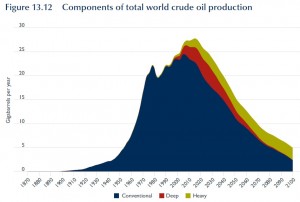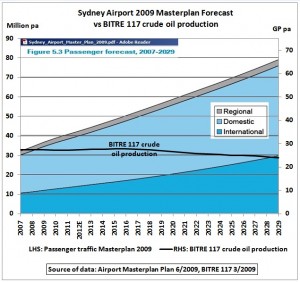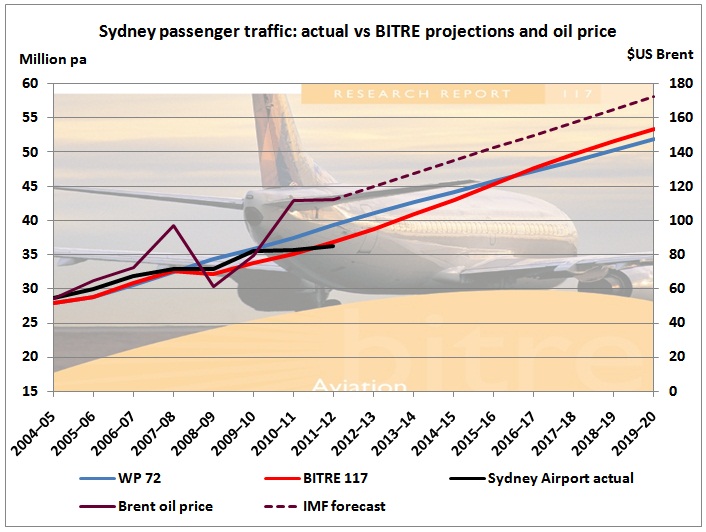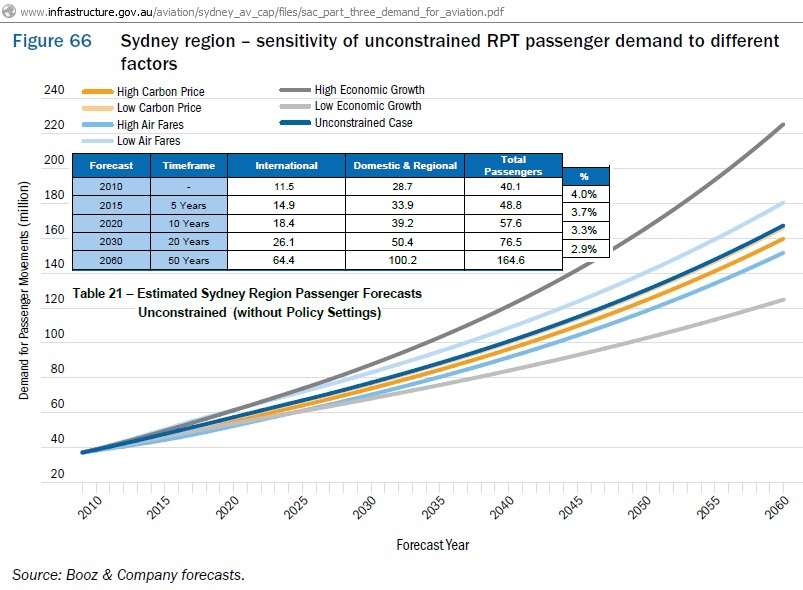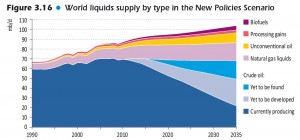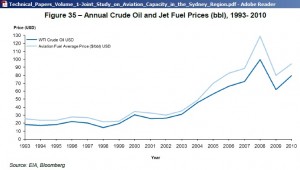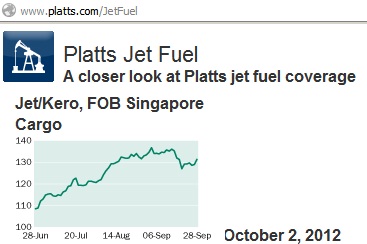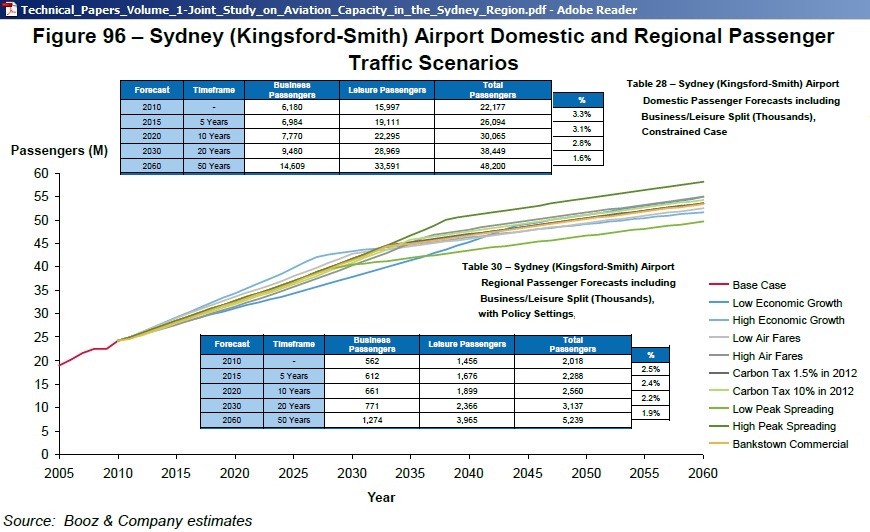With the publication of the “20 year State Infrastructure Strategy” by INSW the thorny issue of a second Sydney airport was raised again. High time to look at air traffic statistics.
Summary
According to a graph in the Sydney Airport Master Plan of 2009, there should have been 42.5 million passengers at Kingsford-Smith airport in 2012. But extrapolating y-o-y growth data up to August this year, passenger traffic in 2012 is likely to be just 36.3 million or 85% of this estimate.
In two later airport studies after 2009, future passenger traffic for 2029/30 of 78.9 million was reduced twice:
- In 2010, by BITRE to 72.8 m
- In March 2012, by a Joint Study group under Infrastructure Australia to 65 m
The Joint Study group sees 50.6 million passengers in 2020 or a growth of 1.5 million passengers pa. Starting with 35.7 m in 2010 that would mean 38.7 m in 2012 compared to the more likely figure of 36.3 m, still a shortfall of 6%.
If trends of the last 5 years continued, the growth path would be substantially different to any of the above 3 projections. And by the way, INSW – by claiming in the above document there will be 80 million passengers by 2031 – got the numbers wrong. According to Fig 86 in part 4 of the Joint Study Group that should be around 69 m. Not that it would matter much because all forecasts are unrealistically high as we will see.
(1) 2009 Sydney Airport Master Plan
First, we look at the graph in the 2009 Masterplan:
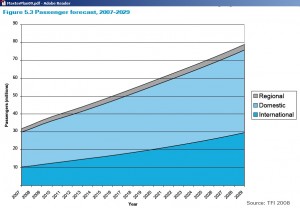 Sydney airport passenger forecast prepared in June 2009 (based on TFI 2008) http://www.sydneyairport.com.au/corporate/community-environment-and-planning/master-plan.aspx
Sydney airport passenger forecast prepared in June 2009 (based on TFI 2008) http://www.sydneyairport.com.au/corporate/community-environment-and-planning/master-plan.aspx
In Chapter 5 of the Masterplan we find:
- From 2000 to 2007, total annual passengers increased from 25.3 million to 31.9 million or 4.3 % pa
- Forecasts were prepared by Tourism Futures International and peer-reviewed by Booz Allen Hamilton (details not included in the Masterplan)
- Factors taken into account: OECD GDP, Australian GDP, Australian TWI, NSW Gross State Product, population forecasts for Australian States, overseas visitor markets, airline capacity, air fares, fuel costs, and airline schedules.
- Growth from 31.9 million passengers in 2007 to 78.9 million in 2029 or 4.8 % pa for international and 3.9 % pa for domestic passengers, giving an average of 4.2% pa
The growth rate of 4.2% pa is assumed to be exponential: 78.9 million =31.9 x (1.042)^22 in 2029. However, the graph above shows actually a linear growth of +2.1 million passengers pa or (78.9/31.9 – 1)/22 = 6.7 % pa.
(2) Actual data
Actual data are from the Sydney Airport Traffic Performance reports.
http://www.sydneyairport.com.au/investors/news-and-events/asx-releases.aspx
 Total passenger movements (international and domestic) increased by 3.9% pa over 11 years. While international traffic grew continuously, domestic traffic stayed practically flat at around 24 million pa since 2010.
Total passenger movements (international and domestic) increased by 3.9% pa over 11 years. While international traffic grew continuously, domestic traffic stayed practically flat at around 24 million pa since 2010.
Here is the comparison between 2011 and 2012:
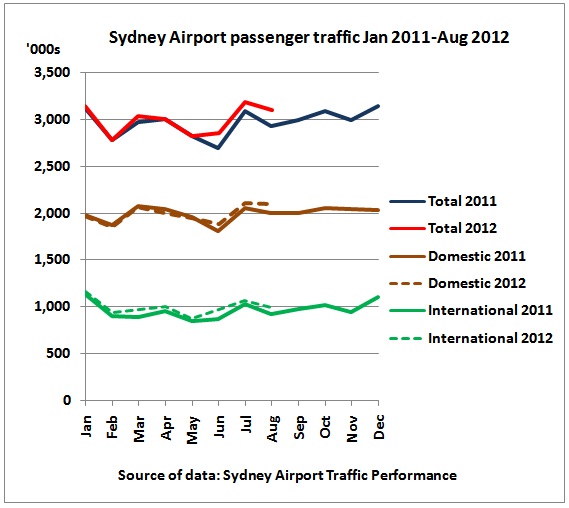 There was practically no growth y-o-y for the first 5 months Jan-May 2012. Since then growth rates varied between 3% and 6%. If growth rates continue at 5% for the rest of the year, annual passengers for 2012 will be around 36.3 m
There was practically no growth y-o-y for the first 5 months Jan-May 2012. Since then growth rates varied between 3% and 6%. If growth rates continue at 5% for the rest of the year, annual passengers for 2012 will be around 36.3 m
Superimposition of actual data on the above forecast graph:
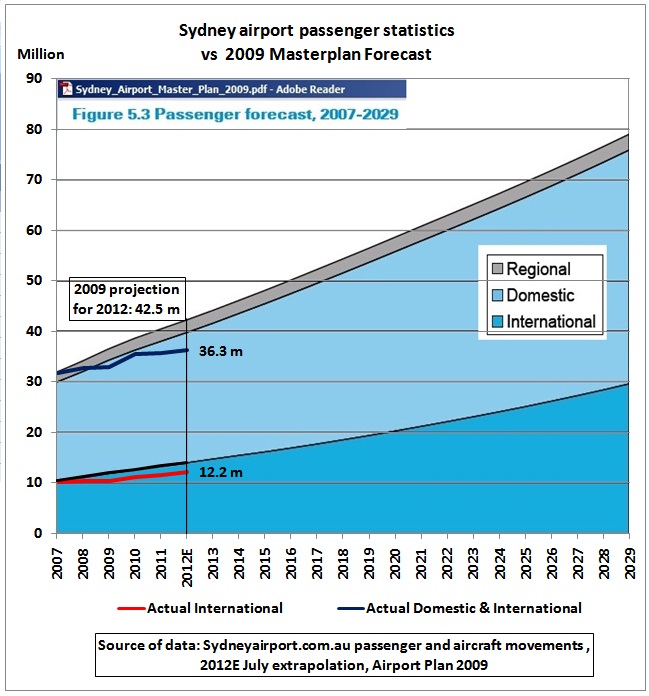 We see that for both domestic and international flights growth is below 2009 forecasts.
We see that for both domestic and international flights growth is below 2009 forecasts.
Over 5 years international passengers numbers increased by 3.7% pa and domestic by 2.3% giving a total of 2.8% (instead of 6.7% on the graph). According to the forecast, Sydney should have 42.5 million passengers in 2012, but in all likelihood will only have 36.3 m.
(3) The year 2009
The Sydney Airport Masterplan was released in September 2008 for public consultation and then approved by the Federal Government in June 2009. In that year, it should have been clear that something was wrong with the world economy, the financial system and oil supplies.
The Brookings Institute published this paper in February/March 2009
Causes and Consequences of the Oil Shock of 2007–08
Whereas historical oil price shocks were primarily caused by physical disruptions of supply, the price run-up of 2007-08 was caused by strong demand confronting stagnating world production. Although the causes were different, the consequences for the economy appear to have been very similar to those observed in earlier episodes, with significant effects on overall consumption spending and purchases of domestic automobiles in particular. In the absence of those declines, it is unlikely that we would have characterized the period 2007:Q4 to 2008:Q3 as one of economic recession for the U.S. The experience of 2007-08 should thus be added to the list of recessions to which oil prices appear to have made a material contribution.
Back in Australia, in the same month, March 2009, BITRE completed its report 117 with a crude oil peak around 2016/17, followed by terminal decline. 3 months later the Masterplan was approved. Obviously no one in the Ministry for Resources told the Federal Transport Minister, Sydney Airport and its consultants about their research:
We superimpose this crude oil forecast with the Sydney Airport Masterplan graph:
We may also note that the consultants did not pick up the IEA’s November 2008 World Energy Outlook (WEO 2008)
 http://www.iea.org/w/bookshop/add.aspx?id=353
http://www.iea.org/w/bookshop/add.aspx?id=353
with its decline rate analysis and a practically flat conventional crude oil production curve. Aircraft cannot fly on natural gas plant liquids (yellow growing area)
(4) Another BITRE 117 report, in April 2010
The original BITRE 117 on peak oil was never published and was later replaced – ironically – by a report with the same serial number 117, but on capital city airports, of course ignoring peak oil. That report therefore also sees endless growth of air traffic, albeit at a slightly smaller rate, up to 72.9 million passengers by 2030.
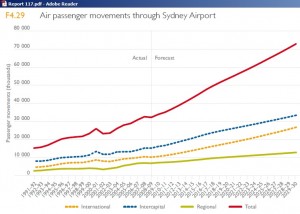 http://www.bitre.gov.au/publications/55/Files/Report%20117.pdf
http://www.bitre.gov.au/publications/55/Files/Report%20117.pdf
This report is an update of BITRE’s May 2008 working paper 72 “Air passenger movements through capital city airports to 2025/26, adjusting for the apparent dent in growth as a result of the global financial crisis in 2008/09. BITRE assumes that growth lost in this period will be compensated with higher growth rates later, to reach previous estimates by 2016 and then even exceed them.
Although actual and forecast traffic is almost on the same level in 2012, the trend of the last 3 years suggests that the assumption of higher growth rates making good the impact of the GFC seems to be too optimistic.
What is more important, however, is that BITRE’s 2010 report does not contain any sensitivity analysis in relation to oil prices. The WP72 found that a notional 50% increase in fuel prices (from early 2008 price levels of around $95) would increase airfares by 17.7%, reducing the base case growth from 4% to 3.4 %. The above graph, however, shows that an increase of oil prices from $95 to $ 110 (+16%) has brought passenger growth down to zero in 2010-11 and 1.8% in 2011-12.
The dotted line in the above graph is the oil price estimate from the IMF which assumes that a global GDP growth of 4% pa (which would be needed to underpin BITRE’s perpetual air traffic growth scenario) needs an extra 8 mb/d by 2021which would require an oil price of $180 a barrel in 2021 to actually come to market. http://www.imf.org/external/pubs/ft/wp/2012/wp12109.pdf
No airline will survive these oil prices. On the other hand, if this economic growth does not materialize, oil prices could be lower but then a weak economy would not support the assumed air traffic growth.
(5) Joint Study Group’s exponential future
Joint Study on Aviation Capacity for the Sydney Region
March 2012
Demand for aviation in the Sydney Region (incl. Canberra and Newcastle, RPT = Regular Public Transport)
https://www.infrastructure.gov.au/aviation/sydney_av_cap/index.aspx
The Joint Study Group goes beyond the projection period of the previous reports and comes up with yet another perpetual growth graph.
http://www.infrastructure.gov.au/aviation/sydney_av_cap/files/sac_part_three_demand_for_aviation.pdf
We see an exercise in drawing exponential functions (HSC, Math level 2) with various growth rates, trying to beat all previous studies by extrapolating demand growth for the Sydney Region to a fantastic (unconstrained) 164.6 million passengers by 2060.
The Joint Study was published one month before the above mentioned IMF report, but it should have been aware of the IMF’s “World Economic Outlook”, released a year earlier in April 2011, which warned of a looming oil scarcity.
http://www.imf.org/external/pubs/ft/weo/2011/01/pdf/text.pdf
The Joint Study also did not look at the IEA WEO 2011 (published in November 2011) showing that crude oil production will basically remain flat until 2035 (which means the economy will not grow as expected)
http://www.worldenergyoutlook.org/publications/weo-2011/
Neither did the Joint Study look at the original BITRE 117 report which calculated a crude oil production drop of 50% (BITRE 117) by 2060, as shown in this superimposition:
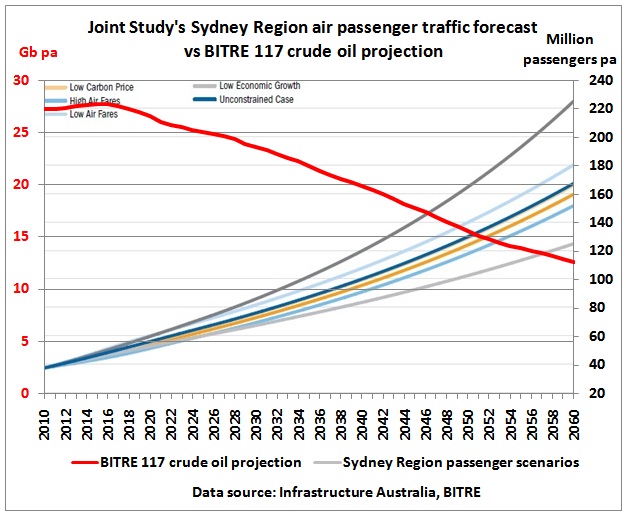 The above graph is for all airports in the Sydney region. For Kingsford-Smith airport, the Joint Study comes up with following passenger numbers (unconstrained demand)
The above graph is for all airports in the Sydney region. For Kingsford-Smith airport, the Joint Study comes up with following passenger numbers (unconstrained demand)
| Million passengers pa |
2010 |
2020 |
2035 |
2060 |
| International |
11.5 |
17.9 |
29.7 |
62.7 |
| Domestic |
24.2 |
32.7 |
47.1 |
82.9 |
| Total |
35.7 |
50.6 (+ 4.2% pa) |
76.8 (+ 3.5% pa) |
145.6 |
(from part 3, page 103)
In part 4, the Joint Study report then calculates the theoretical capacity limitations at Sydney’s airport:
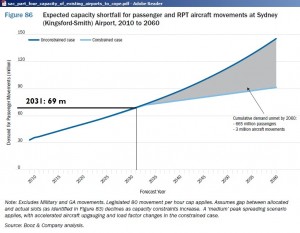 coming to the conclusion that by 2035 Sydney’s usable capacity is exhausted. (note there are 69 m passengers in 2031, not 80 m as claimed by INSW on page 50 of their report)
coming to the conclusion that by 2035 Sydney’s usable capacity is exhausted. (note there are 69 m passengers in 2031, not 80 m as claimed by INSW on page 50 of their report)
Booze & Company modelling
“Figure 34 illustrates the decline in real Australian domestic air fares since 1999. It shows that discount economy air fares have dropped by around 0.6 per cent per annum between 1999 and 2011.”
The authors of the Joint Study have cherry picked “Best Discount” from the BITRE database. Let’s have a look at business class and full economy for which there is definitely not a clear long-term decline of the index. Although the business class index (blue) has dropped sharply recently, the full economy class index (brown) has rebounded in the same period.
Moreover, BITRE describes the methodology as follows: “The series is a price index of the lowest available fare in each fare class, weighted over selected routes. It does not measure real airline yields, or average fares paid by passengers”
http://www.bitre.gov.au/statistics/aviation/air_fares.aspx#graphs
Yet, despite these BITRE caveats, the Joint Study report continues:
“Air fares are expected to continue to decline given the continued increase in market share by LCCs and improvements in technology leading to more cost efficient aircraft. This trend in real air fares could be offset to some extent by increases in fuel prices. Fuel costs make up a significant proportion of airline operating costs, with fuel making up nearly a quarter of Qantas Group‟s expenditure. Any increase in fuel prices puts additional pressure on airline profits, and airlines are likely to pass these costs onto passengers either through increasing air fares or imposing a fuel surcharge, which is likely to increase the cost of travel and therefore dampen demand for air travel. As shown in Figure 35, jet fuel prices increase steadily from 2003, peaking at close to USD130 per barrel in 2008. Prices dropped in 2009 but saw recovery in 2010 as demand for oil increased as economies emerged out of recessionary periods following the GFC.”
It is strange that a report which was published in early 2012 does not contain data for 2011because this would have shown another substantial and sustained increase in jet fuel prices. This is the latest graph from IATA:
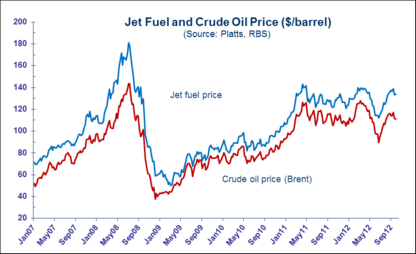 http://www.iata.org/whatwedo/PublishingImages/fuel/ChartB.png
http://www.iata.org/whatwedo/PublishingImages/fuel/ChartB.png
And from Platts:
Disregarding future, physical oil supply scenarios, the study comes to the conclusion that even in a high air fare (=high oil price) scenario real air fare changes will be zero over decades to come.
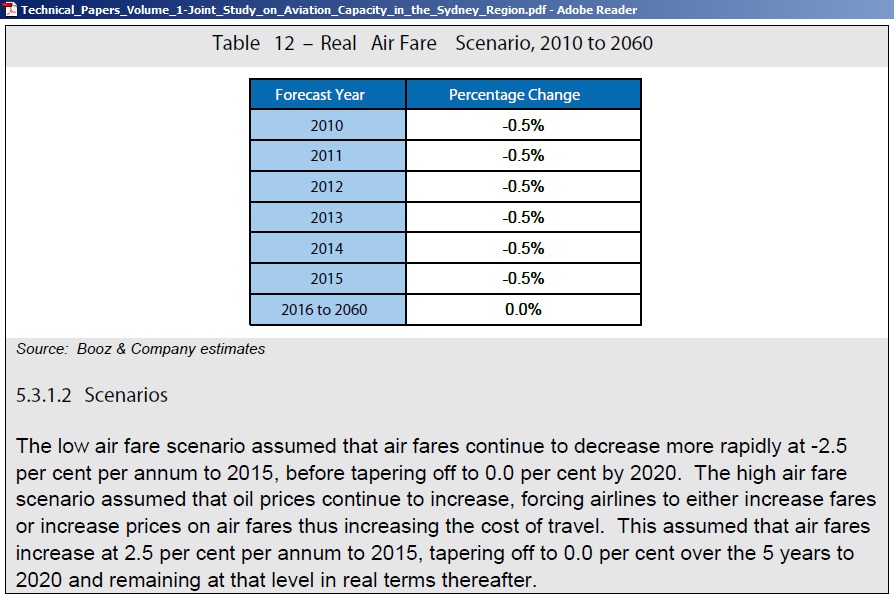 These scenarios mean that whatever the oil price, it will be absorbed in real terms by the airline industry in terms of expected GDP growth, passenger demand (purchasing power) and operating cost. This is an untested assumption.
These scenarios mean that whatever the oil price, it will be absorbed in real terms by the airline industry in terms of expected GDP growth, passenger demand (purchasing power) and operating cost. This is an untested assumption.
The different scenarios for different parameters:
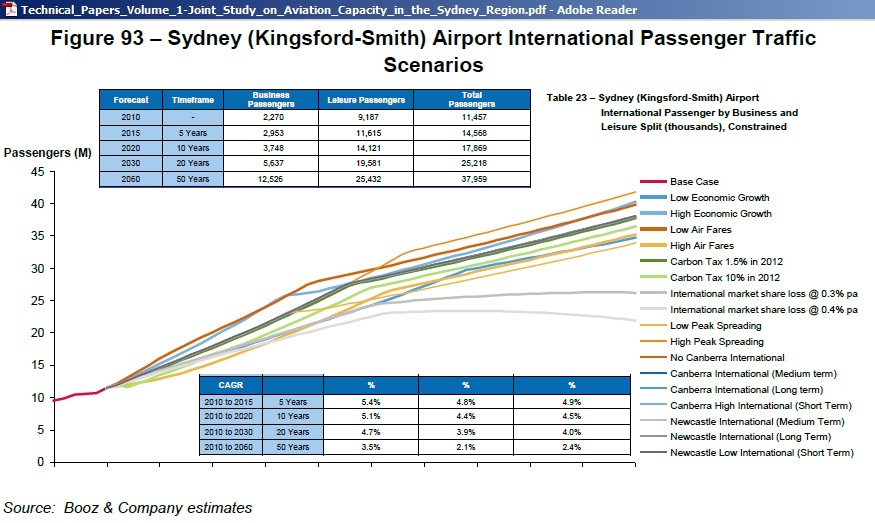 The tables (inserted by author) represent the base case scenario. The kink results from capacity constraints of Sydney’s airport. Oil supplies have been forgotten as a constraint.
The tables (inserted by author) represent the base case scenario. The kink results from capacity constraints of Sydney’s airport. Oil supplies have been forgotten as a constraint.
(6) Altogether now
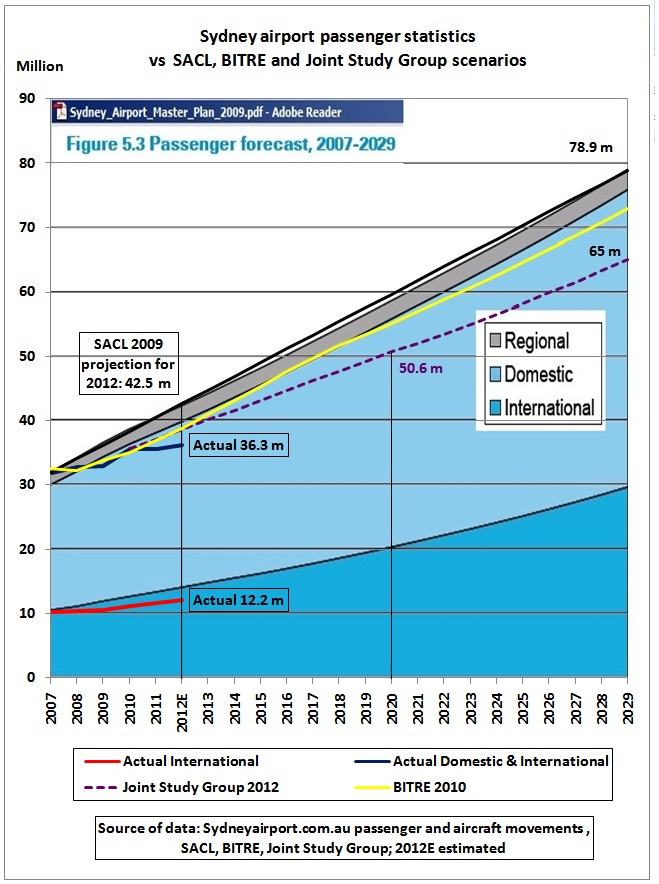 All 3 forecasts compared to actual passenger data. The gap between forecasts and reality is widening.
All 3 forecasts compared to actual passenger data. The gap between forecasts and reality is widening.
(7) Outlook on the end of the boom
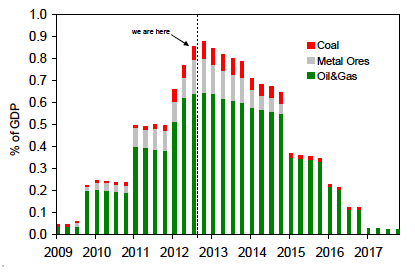 http://2.static.australianindependentbusinessmedia.com.au/sites/default/files/styles/ak_graph/public/kohlersgraphs/2012/Oct/121005-investment.png
http://2.static.australianindependentbusinessmedia.com.au/sites/default/files/styles/ak_graph/public/kohlersgraphs/2012/Oct/121005-investment.png
Investments as a percentage of GDP are shown in this graph on Alan Kohler’s website
sourced from Deloitte Access Economics. The graph is titled “At the summit” – avoiding the word peak.
That will certainly impact on air traffic.
Conclusion:
The last 5 years of air traffic growth do not suggest that Sydney Airport is on the trajectory envisaged in the above documents. What we see here is the 1st phase of peak oil, i.e growth less than assumed.
In part 2 of this airport series we’ll look at jet fuel supplies and Sydney Airport’s debt.
Quote from Mr. Fixit’s infrastructure document
“Passenger volumes at Sydney Airport are set to more than double from present levels over the next 20 years to over 80 million passengers in 2031, increasing from around 40 million in 2010”.
http://www.infrastructure.nsw.gov.au/media/16970/sis_report_section3.0_print.pdf
Related links:
5/12/2011
Australian intercity rail run-down and unprepared to replace domestic flights after peak oil
http://crudeoilpeak.info/australian-intercity-rail-run-down-and-unprepared-to-replace-domestic-flights-after-peak-oil
17/2/2010
Report card 2009 (part 2): Aviation and airport plans – pies in the skies
http://crudeoilpeak.info/report-card-2009-part-2-aviation-and-airport-master-plans-pies-in-the-skies
